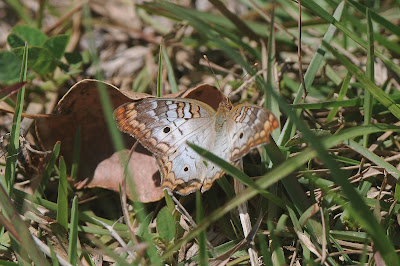Let's be honest, the decision to drive from Florida to Indiana for the SPOTTED REDSHANK wasn't all that hard to make. Shorebirds have long interested me more than others and with a chance to see this Eurasian visitor, it was impossible for me to ignore this sighting.
Five states later, I made it to Goose Pond Fish and Wildlife Area and immediately found the long line of cars parked along the side of the road. The main question was whether the bird was going to be easy (and be in the field along the road) or hard (in the flooded field a mile out along the levee). From the grumpy-looking people milling about with their caffeine-induced consciousness slowly draining from their faces, I figured it was going to be hard. It was worse. Nobody had seen the bird in more than 4-5 hours. Of course, you don't let news like that go to your head. I mean, I wouldn't miss this bird by mere hours after driving all the way from Florida, right? Riiighttt? Hmm...
I joined the throngs of people scanning the fields. There was a real depression hanging in the air. Or maybe that was my breath (it was REALLY cold!). I traded phone numbers with a few birders in case they caught wind of it being seen elsewhere. Hours went by. Then a rumor started to trickle in from somewhere that somebody had the bird. Really? Where? It was posted on the Indiana listserve... and I'm sitting there and was clueless to the fact. Who the crap posted it?! Why wasn't anyone rushing to the spot? WHERE IS IT? We all gathered by the distant pond, apparently somebody was "pretty sure" they had it somewhere out there. We all scanned the pond thoroughly, no bird. Then a bunch of the yellowlegs got up and flew out of the pond altogether. The group disbanded and everybody sluggishly went following the birds to who-knows-where. I decided I'd rather stay and keep scanning where we had been for the last hour. All the people probably thought I was nuts.
It wasn't more than 10 minutes later when my scope passed this:
Woaha! Yep, that's my bird! I made a phone call to one of the other birders and the whole herd rushed back to the spot. Although the sun was getting low in the sky, we all were able to study the bird. I took some more pictures too:
Whew, that was kind of a close call. At least that's what I thought. Turns out, it REALLY WAS a close call. After I left the bird that evening, no one saw the bird again! Ok, well, nobody saw it again for another month or so (then somebody DID find it again). My drive to Indiana was not wasted.
The plan for after Indiana was to chase a different shorebird, this one was a long-staying rarity in Virginia. The BLACK-TAILED GODWIT was the last godwit in the world I needed and I had been eyeing this specific rarity for months.
So after a couple of days of driving from Indiana, through Kentucky and West Virginia, I finally arrived at Chincoteague Island, Virginia. This rarity didn't take quite as long; maybe 2 hours went by before somebody spotted it. Success looked like this (Marbled Godwit on the left, Black-tailed Godwit on the right):
So I was in Virginia and two lifers richer. Where to next? My job in Georgia didn't start until 15 April, ten days from then. It was high-time to go back to Florida, visit with family, and take it easy until my job began.
Starting south that day, the hundreds of NORTHERN GANNETS and a single PURPLE SANDPIPER along the Chesapeake Bay bridge/tunnel made things interesting:
On to Florida. More later from the Sunshine State....












































